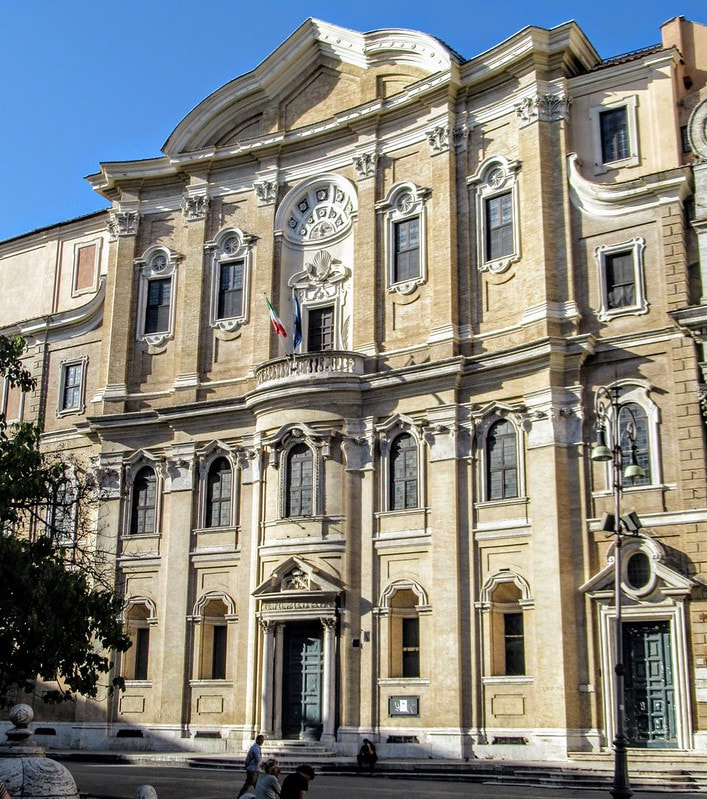
Oratorio dei Filippini Borromini Facade design, Architecture, Architect
The library is situated in Francesco Borromini's Oratorio dei Filippini building on Piazza della Chiesa Nuova. Manuscripts, incunabula, and books totaling over 130,000 volumes are kept in the library. In addition, there are over 3,000 Latin and Greek manuscripts, including an Alcuin-owned Bible from the ninth century and a lectionary from the.

Francesco Borromini Photos and Premium High Res Pictures Getty Images
Oratorio dei Filippini URI http://hdl.handle.net/1721.3/118742 Date 1637-1665 Description Upper floor, central window; Borromini's finest achievement here is the façade of the oratory hall.

Oratorio dei Filippini, Roma by BORROMINI 16371650 Convent + oratory
L' oratorio dei Filippini è un edificio religioso costruito da Francesco Borromini tra il 1637 e il 1667 a Roma . Indice 1 Costruzione 2 Edificio 3 Storia 4 Note 5 Voci correlate 6 Altri progetti 7 Collegamenti esterni Costruzione

Francesco Borromini, Oratorio dei Filippini, Roma Abstract artwork
Walking Tours of Rome Borromini's Clock Tower 22/5/2020 Map Clock Tower, Oratorio dei Filippini The charming clock tower of the Oratorio dei Filippini ( Oratory of San Filippo Neri) was designed by Francesco Borromini (1599-1667) and built between 1647 and 1649.

Francesco Borromini, Facciata dell'Oratorio dei Filippini in Roma
Oratorio dei Filippini & Biblioteca Vallicelliana. Borromini took over this project from another architect who lacked adequate engineering expertise. A near-impossible agenda called for squeezing a series of new spaces in and around several existing structures and somehow uniting everything into a single building.

Francesco Borromini. Oratorio dei Filippini. Roma. (16371643) Camino
semplificata dello stile austero e tecnicamente rigoroso del Borromini, così come riassunto nella facciata dell'Oratorio dei Filippini a Roma. All'interno la decorazione monocroma a stucco anch'esso di suggestione borrominiana , dà particolare risalto alle grandi tele settecentesche che ornano gli altari.

Italy, Rome, Oratorio dei Filippini (Borromini, 17th century Stock
The Palazzo dei Filippini complex consists of the Convent and Oratory, and occupies a large block between Piazza della Chiesa Nuova, Via dei Filippini, Piazza dell'Orologio, Via del Governo Vecchio and Via della Chiesa Nuova.It was designed by Borromini, who won in 1637 the competition announced by the Filippini Fathers for the construction of the new buildings.

Francesco Borromini Oratorio dei Filippini (16371640) Corso
Oratory of Saint Philip Neri (Oratorio dei Filippini) Oratory of Saint Philip Neri In the late sixteenth century, the Congregation of the Filippini (also known as the Oratorians) rebuilt the church of Santa Maria in Vallicella (known as the Chiesa Nuova -new church) in central Rome.

Roma, Borromini Oratorio Filippini a photo on Flickriver
Francesco Borromini (1599-1667) was the most innovative and imaginative architect of the Italian Baroque tradition. Along with his contemporaries Gian Lorenzo Bernini and Pietro da Cortona, Borromini was responsible for creating the Baroque architectural style that eventually spread throughout the world.

Rom, Piazza della Chiesa Nuova, Oratorio dei Filippini von Borromini
Il complesso del Palazzo dei Filippini è costituito dal Convento e dall' Oratorio, e occupa un vasto isolato compreso tra piazza della Chiesa Nuova, via dei Filippini, piazza dell'Orologio, via del Governo Vecchio e via della Chiesa Nuova.

L'Oratorio dei Filippini e le architetture del Borromini, visite
Appunto di storia dell'arte che, partendo dal significato di "oratorio", descrive la facciata dell'Oratorio dei Filippini, dimostrando poi, attraverso diversi dettagli, che nella vena.

Oratorio Dei Filippini Italy architecture, Historical architecture
Exterior view. 1637-50. Photo. Oratorio dei Filippini, Rome. The brethren of the Congregation of St Philip Neri had for a considerable time planned to build an oratory next to their church of Santa Maria in Vallicella. In conjunction with this idea, plans ripened to include in the building programme a refectory, a sacristy, living quarters for.

Francesco Borromini. Oratorio dei Filippini. Roma. Torre dell'orologio
The Oratorio dei Filippini ( Oratory of Saint Philip Neri) is a building located in Rome and erected between 1637 and 1650 under the supervision of architect Francesco Borromini - in his distinctive style. The oratory is adjacent to the Chiesa Nuova Santa Maria in Vallicella, the mother church of the congregation.

The Oratorio dei Filippini by Francesco Borromini, Rome Walks in Rome
This library, located in the Oratorio dei Filippini complex built by Francesco Borromini, was completed in 1643. The Vallicelliana holds about 130,000 items (manuscripts, incunabula, books), with a main focus on church history, theology, patristics and philosophy. For further information (e.g. access, opening hours, more) please consult the Vallicelliana's homepage.

Borromini’s Oratory of Saint Phillip Neri (Oratorio Dei Filippini Del
Oratorio dei Filippini, Rome: In 1637 Borromini began the plans and building for the Oratory of St. Filippo Neri, one of the major Catholic congregations after the Jesuits. The community had a mother house on the Via Papalis and works continued further south towards Via del Pellegrino. The photo shows the main façade on Via del Pellegrino.

Francesco Borromini. Oratorio dei Filippini. Roma. (16371643) Eiffel
The Oratorio dei Filippini is a building located in Rome and erected between 1637 and 1650 under the supervision of architect Francesco Borromini - in his distinctive style. The oratory is adjacent to the Chiesa Nuova Santa Maria in Vallicella, the mother church of the congregation.